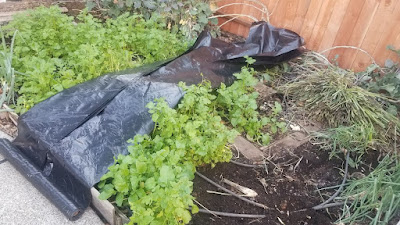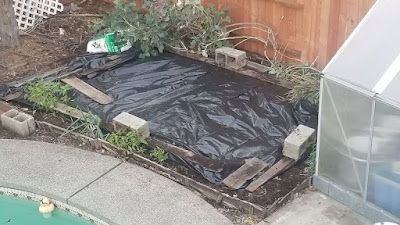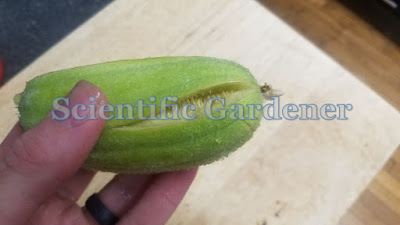So back in the fall of 2020 I thought of a fabulous idea. What if, instead of going through the work of growing another cover crop this winter, I just fallow the garden instead? With that thought, I decided to cover the garden with plenty of compost and a very nice leaf mulch. Everything went beautifully. That is until it came time to plant. The soil that had once grown healthy vigorous cucurbits was now nearly toxic to my cucumber transplants. All of the plants grew very slowly and performed poorly for several weeks in a row.
 |
| A struggling cucumber plant weeks after transplanting. |
To test if the issue was the soil I did the following, which I now call the “Triple Sterilization Method” to clean the soil of any possible disease or pests that might be hindering my crop. Here are the steps to the method:
1. Get a plastic trash bag
2. Remove a layer of diseased garden soil and deposit it in the black bag.
3. Add brassicas and mustard greens (as a biofumigant)
4. Add nitrogen-rich water-soluble fertilizer
5. Add any water to make it moist.
6. Tie off bag and put in another black bag, if needed, to ensure everything is sealed.
7. Put in a warm sunny place (I put it in my greenhouse with the door closed)
8. Wait 1-2 weeks, then dump soil back into place, let it cool, then use for growing.
 |
| Returning soil to garden after Triple Sterilization |
 |
| The new thriving plants after triple-sterilizing the soil |
So – the reason I named this the “Triple Sterilization Method” is because it uses physical heat, chemical heat and biofumigation as a means of sterilizing the soil. The results were impressive. It was not merely because I had added fertilizer, but because I had removed the pathogens that were holding my plants back from thriving.





































